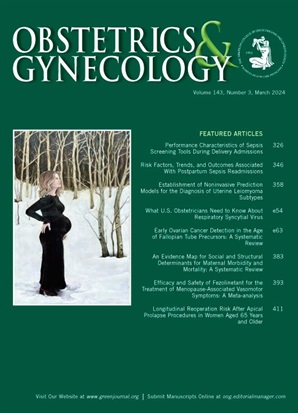阴道内维生素C治疗和预防细菌性阴道病:系统回顾和荟萃分析。
IF 4.7
2区 医学
Q1 OBSTETRICS & GYNECOLOGY
引用次数: 0
摘要
目的评价阴道内维生素C治疗和预防细菌性阴道病的效果,并与对照组和抗生素进行比较。数据来源检索电子数据库(MEDLINE, EMBASE,护理和联合健康文献累积索引,Cochrane中央对照试验注册库),谷歌Scholar,临床试验注册库和灰色文献,检索从成立到2025年5月的任何语言的文章。研究方法:我们纳入了随机试验,包括非怀孕患者和阴道内维生素C治疗急性细菌性阴道病或预防复发。使用covid软件进行研究筛选。采用Cochrane Risk of bias 2工具评估偏倚风险。主要结果是临床或微生物学治愈或复发。结果报告为95% ci的风险比(rr)。结论的确定性用GRADE(建议评估、发展和评价分级)方法报告。纳入9项试验(n= 1107)。8例评估细菌性阴道病的初步治疗,最长随访30天。大多数试验使用每天250毫克的维生素C剂量,持续6天。在这些试验中,四项比较了维生素C与对照组(安慰剂或不治疗)和四项与甲硝唑。只有一项比较维生素C和安慰剂的试验评估了抗生素治愈后复发的预防。我们发现,与对照组相比,维生素C组的短期治愈率(1-3周)更高(66%对42%,RR 1.57, 95% CI, 1.03-2.39,低确定性证据)和甲硝唑组(62%对52%,RR 1.20, 95% CI, 1.03-1.41,极低确定性证据)。与安慰剂组相比,维生素C组在6个月时细菌性阴道病的复发率较低(16% vs 32%, RR 0.50, 95% CI, 0.27-0.93;低确定性证据)。结论阴道内注射维生素C(每日250 mg,连用至少6天)可在短期内提高细菌性阴道病的治愈率,并可预防复发;然而,需要额外的随机试验,特别是评估1个月以上的复发率。系统评价注册号:prospero, crd42024611533。本文章由计算机程序翻译,如有差异,请以英文原文为准。
Intravaginal Vitamin C for the Treatment and Prevention of Bacterial Vaginosis: A Systematic Review and Meta-analysis.
OBJECTIVE
To evaluate the effectiveness of intravaginal vitamin C in the treatment and prevention of bacterial vaginosis compared with control or antibiotics.
DATA SOURCES
Electronic databases (MEDLINE, EMBASE, Cumulated Index in Nursing and Allied Health Literature, and Cochrane Central Register of Controlled Trials), Google Scholar, clinical trial registries, and gray literature were searched for articles in any language from inception to May 2025.
METHOD OF STUDY SELECTION
We included randomized trials involving nonpregnant patients and intravaginal vitamin C as treatment for acute bacterial vaginosis or prevention of recurrence. Covidence software was used for study screening.
TABULATION, INTEGRATION, AND RESULTS
Risk of bias was assessed with the Cochrane Risk of Bias 2 tool. The primary outcome was clinical or microbiologic cure or recurrence. Results were reported as risk ratios (RRs) with 95% CIs. Certainty in conclusions was reported with the GRADE (Grading of Recommendations Assessment, Development, and Evaluation) approach. Nine trials (n=1,107) were included. Eight evaluated primary treatment of bacterial vaginosis, with a maximum follow-up of 30 days. Most trials used a vitamin C dose of 250 mg daily for 6 days. Among these trials, four compared vitamin C with control (placebo or no treatment) and four with metronidazole. Only one trial, comparing vitamin C with placebo, assessed prevention of recurrence after antibiotic cure. We found a higher proportion of short-term cure (1-3 weeks) in the vitamin C group compared with control (66% vs 42%, RR 1.57, 95% CI, 1.03-2.39; low-certainty evidence) and metronidazole (62% vs 52%, RR 1.20, 95% CI, 1.03-1.41; very low-certainty evidence). Recurrence of bacterial vaginosis was lower in the vitamin C group compared with the placebo group at 6 months (16% vs 32%, RR 0.50, 95% CI, 0.27-0.93; low-certainty evidence).
CONCLUSION
Treatment with intravaginal vitamin C (250 mg daily for at least 6 days) may increase cure for bacterial vaginosis in the short term and may prevent recurrence; however, additional randomized trials are needed, particularly to evaluate recurrence beyond 1 month.
SYSTEMATIC REVIEW REGISTRATION
PROSPERO, CRD42024611533.
求助全文
通过发布文献求助,成功后即可免费获取论文全文。
去求助
来源期刊

Obstetrics and gynecology
医学-妇产科学
CiteScore
11.10
自引率
4.20%
发文量
867
审稿时长
1 months
期刊介绍:
"Obstetrics & Gynecology," affectionately known as "The Green Journal," is the official publication of the American College of Obstetricians and Gynecologists (ACOG). Since its inception in 1953, the journal has been dedicated to advancing the clinical practice of obstetrics and gynecology, as well as related fields. The journal's mission is to promote excellence in these areas by publishing a diverse range of articles that cover translational and clinical topics.
"Obstetrics & Gynecology" provides a platform for the dissemination of evidence-based research, clinical guidelines, and expert opinions that are essential for the continuous improvement of women's health care. The journal's content is designed to inform and educate obstetricians, gynecologists, and other healthcare professionals, ensuring that they stay abreast of the latest developments and best practices in their field.
 求助内容:
求助内容: 应助结果提醒方式:
应助结果提醒方式:


